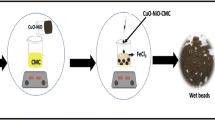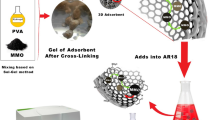Abstract
The problems caused by water pollution are increasingly serious, wastewater contains a lot of heavy metal ions, textile dyes, medicines, etc. However, most adsorption materials usually face problems such as inefficient recycling, high cost, and secondary pollution. As a natural polymer, cellulose has low cost, degradability and good biocompatibility. In this work, by changing the addition amount of sodium hypochlorite during 2,2,6,6-Tetramethylpiperidine-1-oxyl radical (TEMPO) oxidation, nanocellulose with different carboxyl content could be prepared, which is expected to be a good high-efficiency cationic adsorbent due to its rich in hydroxyl groups on the surface and negatively charged. Then the calcium chloride solution was used as the cross-linking agent to prepare TEMPO-oxidized cellulose nanofibril beads (TOCNB) by the dropping solidification method. As the content of carboxyl groups increases, the Zeta potential value of the nanocellulose dispersion became increasingly negative. The nanocellulose beads all presented a good three-dimensional network porous structure. With the increase of carboxyl group content, the specific surface area increases from 173 to 367 m2 g−1, and the adsorption capacity for methylene blue (MB) also gradually strengthened. The saturated adsorption capacity of TOCNB on MB was calculated as high as 925.93 mg g−1. The nanocellulose bead was a cationic adsorbent with highly efficient adsorption and adjustable specific surface area, and the preparation method was simple, fast, efficient and green.








Similar content being viewed by others
Data availability
The datasets used and/or analysis during the current study are available from the corresponding author on reasonable request.
References
Agartan L, Hantanasirisakul K, Buczek S, Akuzum B, Mahmoud KA, Anasori B, Gogotsi Y, Kumbur EC (2020) Influence of operating conditions on the desalination performance of a symmetric pre-conditioned Ti3C2Tx-MXene membrane capacitive deionization system. Desalination. https://doi.org/10.1016/j.desal.2019.114267
Akira Isogai (2020) Emerging Nanocellulose Technologies: recent developments. ADV MATER 33(28):2000630. https://doi.org/10.1002/adma.202000630
Azari A, Nabizadeh R, Nasseri S, Mahvi AH, Mesdaghinia AR (2020) Comprehensive systematic review and meta-analysis of dyes adsorption by carbon-based adsorbent materials: classification and analysis of last decade studies. Chemosphere 250:126238. https://doi.org/10.1016/j.chemosphere.2020.126238
Chen C, Kuang Y, Zhu S, Burgert I, Keplinger T, Gong A, Li T, Berglund L, Eichhorn SJ, Hu L (2020a) Structure–property–function relationships of natural and engineered wood. Nat Rev Mater 5(9):642–666. https://doi.org/10.1038/s41578-020-0195-z
Chen R, Cai J, Li Q, Wei X, Min H, Yong Q (2020) Coadsorption behaviors and mechanisms of pb (ii) and methylene blue onto a biodegradable multi-functional adsorbent with temperature-tunable selectivity. RSC Adv 10(59):35636–35645. https://doi.org/10.1039/d0ra07139k
Chowdhury M, Hossain M, Azad M, Islam M, Dewan M (2018) Photocatalytic degradation of methyl orange under UV using ZnO as catalyst. Int J Engine Res 9. https://doi.org/10.14299/ijser.2018.06
Dai K, Zhao G, Kou J, Wang Z, Zhang J, Wu J, Yang P, Li M, Tang C, Zhuang W et al (2021) Magnetic mesoporous sodium citrate modified lignin for improved adsorption of calcium ions and methylene blue from aqueous solution. J Environ Chem Eng 9(2):105180. https://doi.org/10.1016/j.jece.2021.105180
Dehghani MH, Dehghan A, Najafpoor A (2017) Removing reactive Red 120 and 196 using chitosan/zeolite composite from aqueous solutions: kinetics, isotherms, and process optimization. J Ind Eng Chem 51:185–195. https://doi.org/10.1016/j.jiec.2017.03.001
Fahimirad S, Abtahi H, Satei P, Ghaznavi-Rad E, Moslehi M, Ganji A (2021) Wound healing performance of PCL/chitosan based electrospun nanofiber electrosprayed with curcumin loaded chitosan nanoparticles. Carbohydr Polym. https://doi.org/10.1016/j.carbpol.2021.117640
Gaduan AN, Solhi L, Kontturi E, Lee K-Y (2021) From micro to nano: polypropylene composites reinforced with TEMPO-oxidised cellulose of different fibre widths. Cellulose 28(5):2947–2963. https://doi.org/10.1007/s10570-020-03635-3
Ge Y, Li Z (2018) Application of lignin and its derivatives in adsorption of heavy metal Ions in water: a review. ACS Sustain Chem Eng 6(5):7181–7192. https://doi.org/10.1021/acssuschemeng.8b01345
Hokkanen S, Repo E, Sillanpaa M (2013) Removal of heavy metals from aqueous solutions by succinic anhydride modified mercerized nanocellulose. Chem Eng J 223:40–47. https://doi.org/10.1016/j.cej.2013.02.054
Hong HJ, Lim JS, Hwang JY, Kim M, Jeong HS, Park MS (2018) Carboxymethlyated cellulose nanofibrils (CMCNFs) embedded in polyurethane foam as a modular adsorbent of heavy metal ions. Carbohydr Polym 195:136–142. https://doi.org/10.1016/j.carbpol.2018.04.081
Kriaa A, Hamdi N, Srasra E (2011) Adsorption studies of methylene blue dye on tunisian activated lignin. Russ J Phys Chem A 85(2):279–287. https://doi.org/10.1134/S0036024411020191
Li J, Su Z, Xu H, Ma X, Yin J, Jiang X (2015) Supramolecular networks of hyperbranched poly (ether amine) (hPEA) nanogel/chitosan (CS) for the selective adsorption and separation of guest molecules. Macromolecules 48(7):2022–2029. https://doi.org/10.1021/ma502607p
Li R, Gao B, Guo K, Yue Q, Zheng H, Wang Y (2017) Effects of papermaking sludge-based polymer on coagulation behavior in the disperse and reactive dyes wastewater treatment. Bioresour Technol 240:59–67. https://doi.org/10.1016/j.biortech.2017.02.088
Liu L, Gao ZY, Su XP, Chen X, Jiang L, Yao JM (2015) Adsorption removal of dyes from single and binary solutions using a cellulose-based bioadsorbent. ACS Sustain Chem Eng 3(3):432–442. https://doi.org/10.1021/sc500848m
Liu D, Gao Y, Song Y, Zhu H, Zhang L, Xie Y, Shi H, Shi Z, Yang Q, Xiong C (2022) Highly sensitive multifunctional electronic skin based on nanocellulose/mxene composite films with good electromagnetic shielding biocompatible antibacterial properties. Biomacromolecules 23(1):182–195. https://doi.org/10.1021/acs.biomac.1c01203
Luo Y, Liu M, Chen Y, Wang T, Zhang W (2019) Preparation and regeneration of iron-modified nanofibres for low-concentration phosphorus-containing wastewater treatment. R Soc Open Sci. https://doi.org/10.1098/rsos.190764
Ma Y, Zheng D, Mo Z, Dong R, Qiu X (2018) Magnetic lignin-based carbon nanoparticles and the adsorption for removal of methyl orange. Colloids Surf A 559:226–234. https://doi.org/10.1016/j.colsurfa.2018.09.054
Mishnaevsky L Jr, Mikkelsen LP, Gaduan AN, Lee KY, Madsen B (2019) Nanocellulose reinforced polymer composites: computational analysis of structure–mechanical properties relationships. Compos Struct. https://doi.org/10.1016/j.compstruct.2019.111024
Nagarajan KJ, Ramanujam NR, Sanjay MR, Siengchin S, Surya Rajan B, Sathick Basha K, Madhu P, Raghav GR (2021) A comprehensive review on cellulose nanocrystals and cellulose nanofibers: pretreatment, preparation, and characterization. Polym Compos 42(4):1588–1630. https://doi.org/10.1002/pc.25929
Nagireddi S, Katiyar V, Uppaluri R (2017) Pd (II) adsorption characteristics of glutaraldehyde cross-linked chitosan copolymer resin. Int J Biol Macromol 94:7284. https://doi.org/10.1016/j.ijbiomac.2016.09.088
Oun AA, Shankar S, Rhim JW (2020) Multifunctional nanocellulose/metal and metal oxide nanoparticle hybrid nanomaterials. Crit Rev Food Sci Nutr 60(3):435–460. https://doi.org/10.1080/10408398.2018.1536966
Peng Y, Wang KK, Liu T, Xu J, Xu BG (2017) Synthesis of one-dimensional Bi2O3–Bi2O2.33 heterojunctions with high interface quality for enhanced visible light photocatalysis in degradation of high-concentration phenol and MO dyes. Appl Catal B 203:946–954. https://doi.org/10.1016/j.apcatb.2016.11.011
Qi F, Yan Y, Lamb D, Naidu R, Bolan NS, Liu Y, Ok YS, Donne SW, Semple KT (2017) Thermal stability of biochar and its effects on cadmium sorption capacity. Bioresour Technol 246:48–56. https://doi.org/10.1016/j.biortech.2017.07.033
Qiao A, Cui M, Huang R, Ding G, Qi W, He Z, Klemes JJ, Su R (2021) Advances in nanocellulose-based materials as adsorbents of heavy metals and dyes. Carbohydr Polym. https://doi.org/10.1016/j.carbpol.2021.118471
Saito T, Kimura S, Nishiyama Y, Isogai A (2007) Cellulose nanofibers prepared by TEMPO-mediated oxidation of native cellulose. Biomacromolecules 8(8):2485–2491. https://doi.org/10.1021/bm0703970
Sarmah D, Karak N (2020) Double network hydrophobic starch based amphoteric hydrogel as an effective adsorbent for both cationic and anionic dyes. Carbohydr Polym 242:116320. https://doi.org/10.1016/j.carbpol.2020.116320
Shahid S, Sultana T, Sultana S, Hussain B, Irfan M, Al-Ghanim KA, Misned FA, Mahboob S (2021) Histopathological alterations in gills, liver, kidney and muscles of ictalurus punctatus collected from pollutes areas of river. Braz J Biol 81(3):814–821. https://doi.org/10.1590/1519-6984.234266
Shi Z, Yang Q, Ono Y, Funahashi R, Saito T, Isogai A (2015) Creation of a new material stream from japanese cedar resources to cellulose nanofibrils. React Funct Polym 95:19–24. https://doi.org/10.1016/j.reactfunctpolym.2015.08.005
Sun Y, Chu Y, Wu W, Xiao H (2021) Nanocellulose-based lightweight porous materials: a review. Carbohydr Polym 255:117489. https://doi.org/10.1016/j.carbpol.2020.117489
Trache D, Tarchoun AF, Derradji M, Hamidon TS, Masruchin N, Brosse N, Hussin MH (2020) Nanocellulose: from fundamentals to advanced applications. Front Chem. https://doi.org/10.3389/fchem.2020.00392
Tumolo M, Ancona V, De Paola D, Losacco D, Campanale C, Massarelli C, Uricchio VF (2020) Chromium pollution in european water, sources, health risk, and remediation strategies: an overview. ACS Sustain Chem Eng. https://doi.org/10.3390/ijerph17155438
Wang H, Zuo M, Ding N, Yan G, Zeng X, Tang X, Sun Y, Lei T, Lin L (2019) Preparation of nanocellulose with high-pressure homogenization from pretreated biomass with cooking with active oxygen and solid alkali. ACS Sustain Chem Eng 7(10):9378–9386. https://doi.org/10.1021/acssuschemeng.9b00582
Xu QH, Wang YL, Jin LQ, Wang Y, Qin MH (2017) Adsorption of Cu (II), pb (II) and cr (VI) from aqueous solutions using black wattle tannin-immobilized nanocellulose. J Hazard Mater 339:91–99. https://doi.org/10.1016/j.jhazmat.2017.06.005
Xu X, Ouyang X, Yang L (2021) Adsorption of pb(II) from aqueous solutions using crosslinked carboxylated chitosan/carboxylated nanocellulose hydrogel beads. J Mol Liq. https://doi.org/10.1016/j.molliq.2020.114523
Xue Y, Mou Z, Xiao H (2017) Nanocellulose as a sustain biomass material: structure, properties, present status and future prospects in biomedical applications. Nanoscale 9(39):14758–14781. https://doi.org/10.1039/C7NR04994C
Zhao S, Wang Z (2017) A loose nano-filtration membrane prepared by coating HPAN UF membrane with modified PEI for dye reuse and desalination. J Membr Sci 524:214–224. https://doi.org/10.1016/j.memsci.2016.11.035
Zhou Y, Lu J, Zhou Y, Liu Y (2019) Recent advances for dyes removal using novel adsorbents: a review. Environ Pollut 252:352–365. https://doi.org/10.1016/j.envpol.2019.05.072
Zhu H, Zhu E, Xie Y, Liu D, Hu Y, Shi Z, Xiong C, Yang Q (2022) Hydrangea-like nanocellulose microspheres with high dye adsorption and drug encapsulation prepared by emulsion method. Carbohydr polym 296:119947. https://doi.org/10.1016/j.carbpol.2022.119947
Acknowledgments
The research was supported by the Shandong Provincial Natural Science Foundation of China (No. ZR202103020328), Hainan Provincial Joint Project of Sanya Yazhou Bay Science and Technology City (Grant No.520LH017), and Hainan Institute of Wuhan University of Technology (2021KF0015).
Funding
Funding was provided by the Shandong Provincial Natural Science Foundation of China (No. ZR202103020328), Hainan Provincial Joint Project of Sanya Yazhou Bay Science and Technology City (Grant No.520LH017), and Hainan Institute of Wuhan University of Technology (2021KF0015).
Author information
Authors and Affiliations
Contributions
JX: Writing—original draft, Investigation, Methodology, Formal analysis. EZ: Writing—review and editing, Validation, Investigation, Data curation, Visualization. HZ: Investigation. DL: Investigation. HC: Conceptualization, Writing—review and editing. CX: Writing—review and editing. QY: Investigation, Writing—review and editing. ZS: Conceptualization, methodology, project administration, Writing—review and editing, supervision.
Corresponding authors
Ethics declarations
Conflict of interest
The authors have no relevant financial or non-financial interests to disclose.
Consent for publication
All authors were informed and agreed to publish in cellulose.
Additional information
Publisher’s Note
Springer Nature remains neutral with regard to jurisdictional claims in published maps and institutional affiliations.
Rights and permissions
Springer Nature or its licensor (e.g. a society or other partner) holds exclusive rights to this article under a publishing agreement with the author(s) or other rightsholder(s); author self-archiving of the accepted manuscript version of this article is solely governed by the terms of such publishing agreement and applicable law.
About this article
Cite this article
Xue, J., Zhu, E., Zhu, H. et al. Dye adsorption performance of nanocellulose beads with different carboxyl group content. Cellulose 30, 1623–1636 (2023). https://doi.org/10.1007/s10570-022-04964-1
Received:
Accepted:
Published:
Issue Date:
DOI: https://doi.org/10.1007/s10570-022-04964-1




